**  USA Customers: Enjoy up to $800 Tax Free Imports - Even with Tariffs, we're still better value than US stores! **
USA Customers: Enjoy up to $800 Tax Free Imports - Even with Tariffs, we're still better value than US stores! **
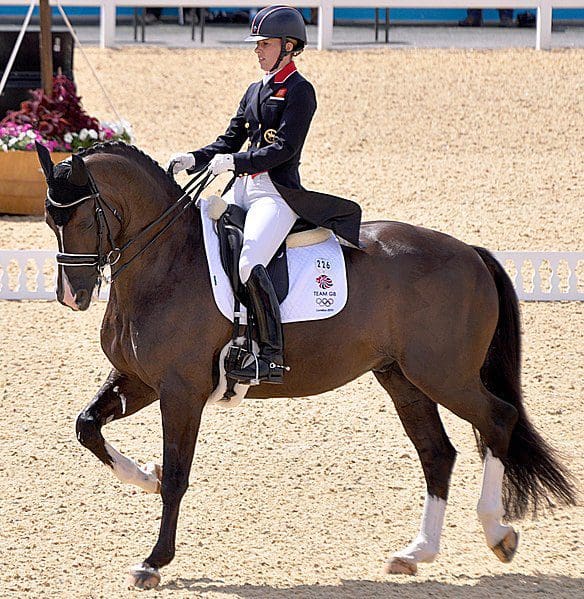
This compendium is the perfect introduction to the equestrian sport of dressage and takes readers on a journey, from how to start dressage, to competing at the highest level and everything in between. Whether you have yet to decide if learning dressage could be beneficial to you, need advice on the best way to start dressage, or just want to learn more about the subject, then this guide is definitely for you.
Even if you have already begun your dressage journey, there is still a lot to learn. Our guide has been written on the assumption that the reader has little or no knowledge of the subject and therefore starts with the basics, before addressing more advanced topics. It is deliberately long because the subject is a complex one and there are many different areas to cover.
For some readers this guide will be used purely as a point of reference and whilst it explains all the different areas relating to dressage, we have also written supporting articles discussing individual topics in more detail. Hopefully, by the end of this guide, you will have a good understanding of “What dressage riding is” and be able to map out a path to achieving your goals.
The word dressage is borrowed from the french language, a french term for the verb “Dresseur”. When translated into English the word dressage means “to train”. It contains two syllables and is pronounced dress-aazh, or dreh-ssazh if you are from the USA.
Horse dressage is thought by some to be the ultimate equestrian sport described as:-
“The highest expression of horse training where horse and rider are expected to perform from memory a series of predetermined movements”. Dressage is both an art and a sport that can take many years of practice to perfect”.
Dressage in horse riding is the quintessence of gracefulness, the artistry of horse and rider working in unison to execute precise movements. The rider issues barely perceptible signals and in response the highly trained horse performs distinct actions. The more advanced the horse and rider, the more complicated the manoeuvres which demand a perfect relationship between horse and rider that can only be achieved through many years of training. Both horse and rider are athletes, a cross between a gymnast and a ballet dancer, requiring both strength and finesse.
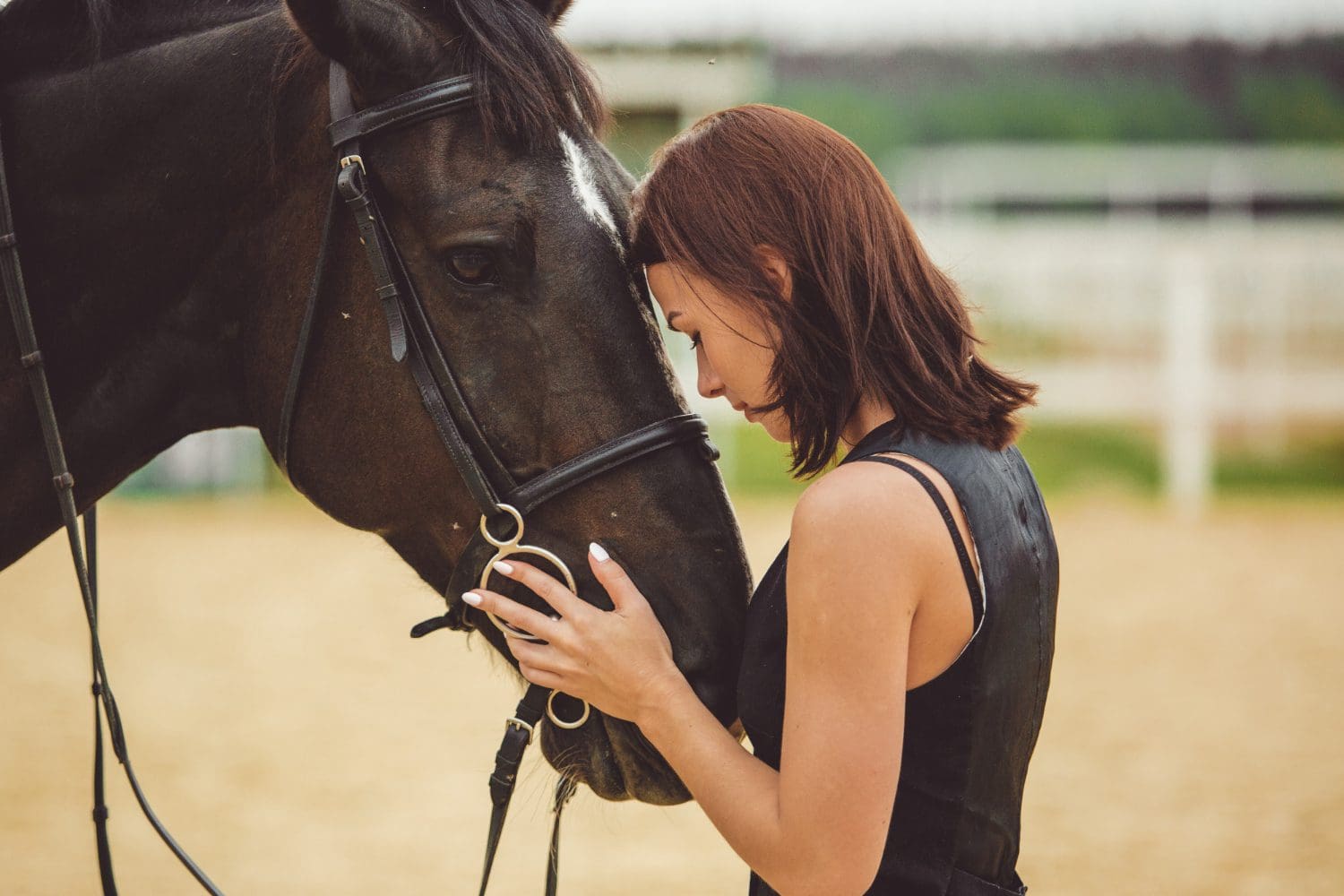
Whilst dressage horseback riding can be performed purely for exhibition purposes, showcasing the qualities of the horse and rider, the objective of most riders is to compete, to take part in dressage competitions, which are held at all levels ranging from amateur local events, to the ultimate competitions, the World Equestrian and Olympic games (the latter having been included since 1912), where competitors perform a combination of predetermined movements in a short arena (20x40m) or a long arena (20x60m). In top-level dressage equestrian, riders compete not only as individuals but have the opportunity to compete in three-person teams. The horse’s deportment and carriage and the rider’s position are marked by up to seven judges depending on the level of the competition.
No one actually invented dressage horse riding, rather it evolved over a long period of time, the origins of which are uncertain but thought to date back to Ancient Greece. The Greek army took Classical Horsemanship to a new level, needing to train their horses to perform in battle. An Athenian Greek Commander and Historian named Xenophon, born around 430 BC, who sought to perfect riding skills and horsemanship, wrote down his ideas for classical dressage training called “On Horsemanship” and these works are the earliest recorded writings ever found.
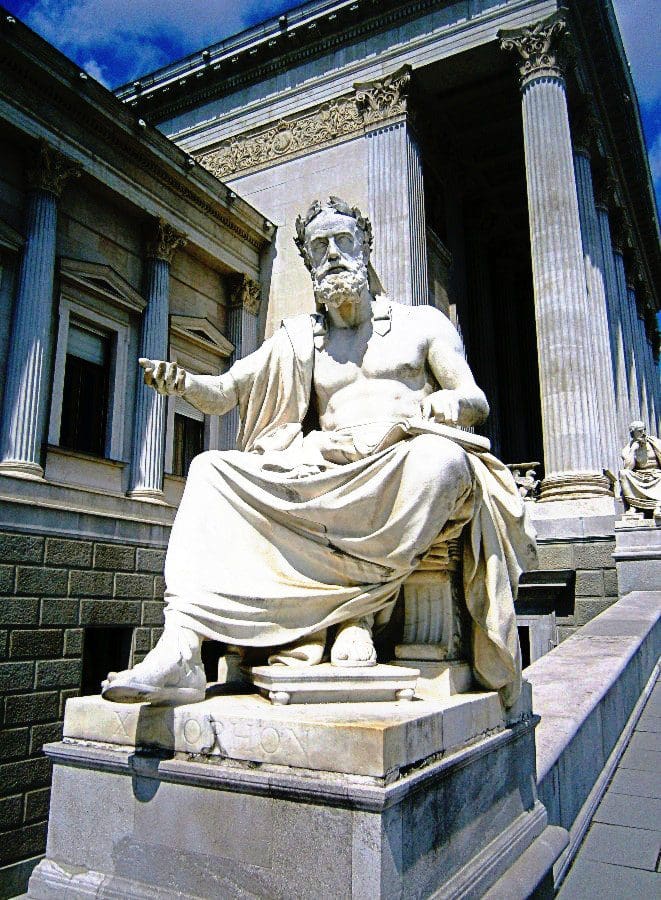
However, it wasn’t until the 14th Century Renaissance period that the rudiments of dressage movements and training methods were being documented. There were several notable characters during that period who made significant contributions to the history of dressage transforming it into more of a cultural art form. The Spanish Riding School of Vienna was created in 1572 and the principles for dressage developed. Over time these methods have formed the basis of all dressage training today and evolved into a competitive sport at the highest levels of modern horsemanship.
Anyone interested in horse riding knows the name Charlotte Dujardin and has more than likely been mesmerised by her International Dressage performances. She epitomizes the elegance and finesse of top-level dressage and whilst for many, this may seem a hopeless dream and out of reach, dressage is about so much more.
Competition is only one facet of the sport. A successful rider in any equestrian discipline requires a strong relationship between horse and rider and all skill levels can enjoy dressage as it provides a safe and effective platform to build the relationship. Dressage is suited to riding horses of any breed as it helps to develop a horse’s natural athletic ability, making it a popular activity for riders looking to improve their bond and communication skills with their horse.
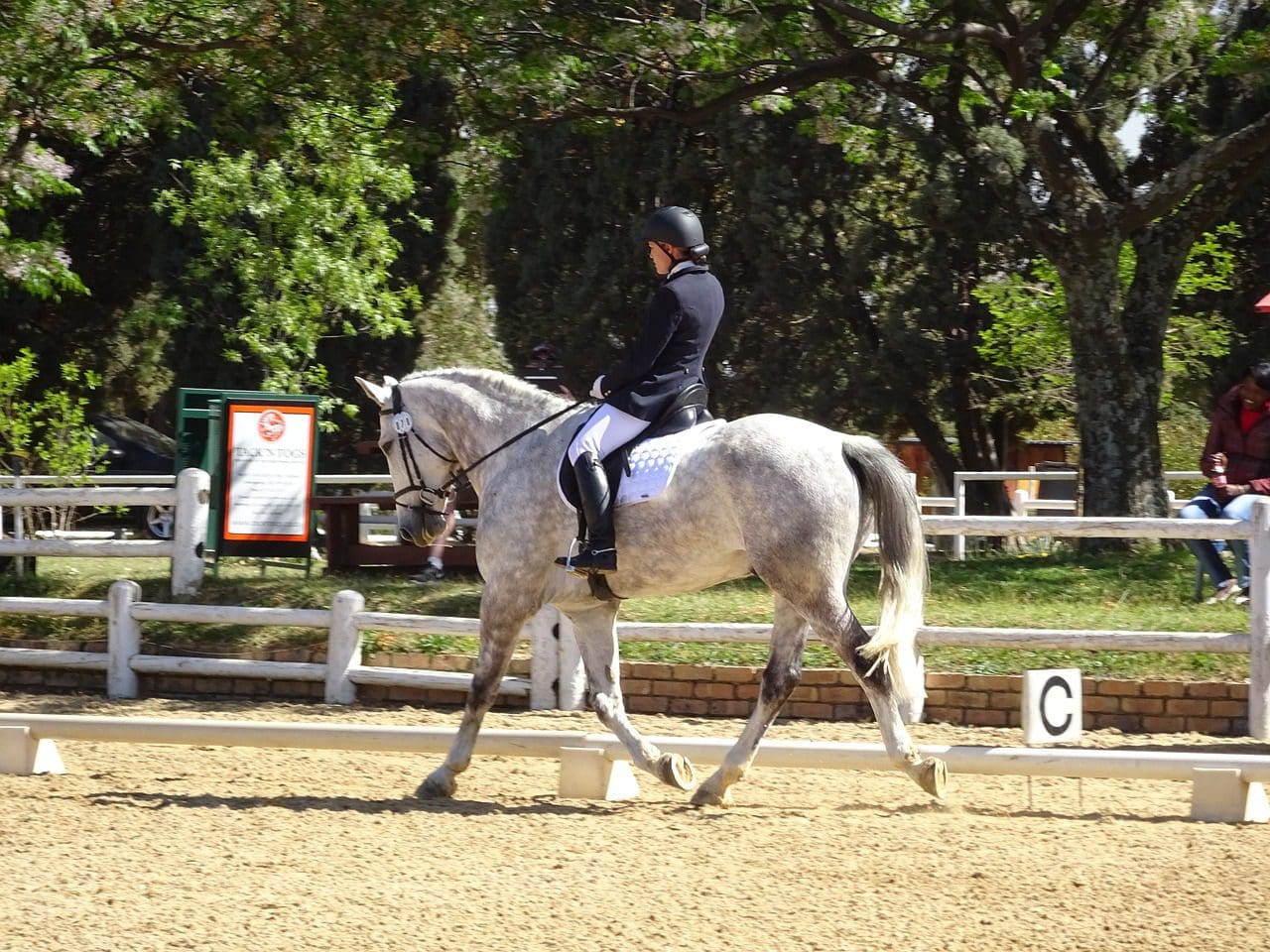
With an emphasis on the development of obedience and communication between the horse and rider through consistent training and precise movements, frequent practice not only assists performance and harmony between the two participants but is beneficial to horse health, balance, suppleness, and strength and no matter what equestrian discipline you are into, be it jumping, cross country, showing or just hacking out, the benefits of dressage training are for everyone.
The simple answer to that question is yes dressage is good for beginners. The foundations of dressage are fundamental techniques that will help any newcomers to the sport develop strong basic skills and start building a relationship with their horse or pony.
Training is normally at a slower more methodical pace with a focus on precision and is a great way to start developing those important skills required to become a competent horserider.
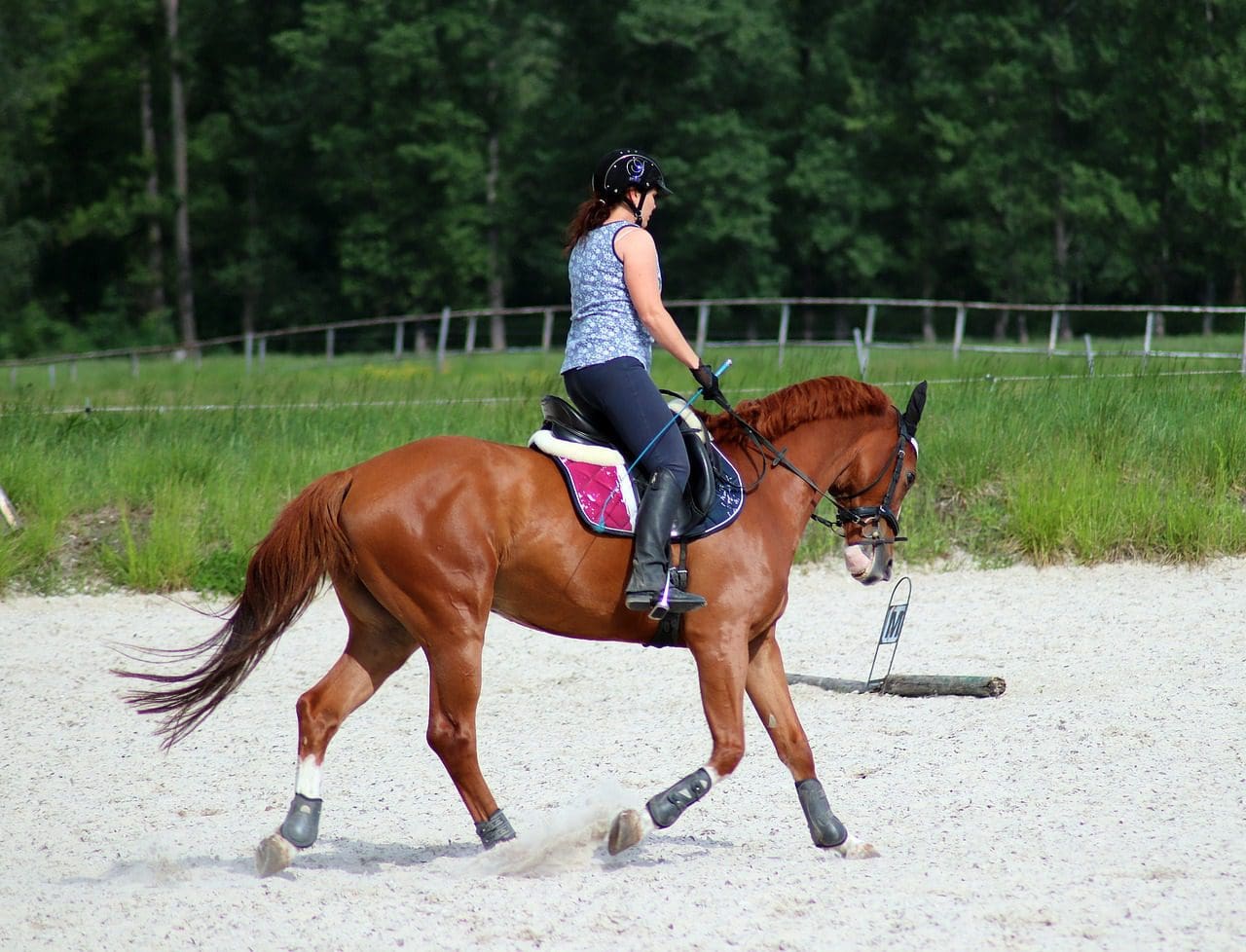
At the same time, your horse will learn balance, coordination, and obedience. It is recommended that you receive proper instruction using a qualified teacher to ensure a steady progression of movements and for any beginner to get the most out of dressage.
There are many benefits to learning even the most basic of dressage movements. Physically it can help improve a horse’s balance, accuracy, strength, and suppleness. Mentally it will improve a horse’s concentration, coordination, mental focus, and confidence. A rider will also benefit from the additional physical exertion required during dressage rider training as well as increased confidence from being able to control a horse’s movement with only very subtle cues.
The final benefit is a closer connection between horse and rider, being able to read a horse’s mood, and energy levels, whether they are feeling well or not, and developing greater mutual trust and respect.
Like any sport, there will always be injuries (humans and animals) but because dressage is progressive in nature, you don’t move on until the horse has built up the necessary strength and fitness to master the current level, there is much less risk of injury.
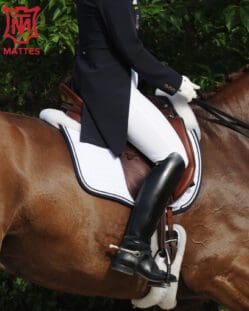
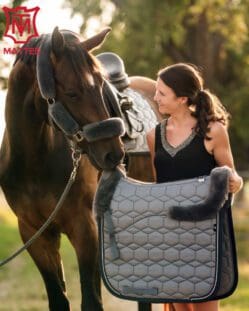
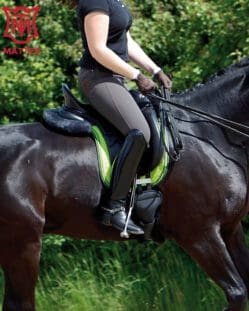

Riding Dressage is not all about teaching your horse to carry out the fancy movements you see on television.
Riding dressage is about understanding and performing the basic elements, even as you become more advanced. The pyramid of training (also known as the scales of training) provides guidelines and acts as a checklist for six core elements, that you should be working through on each movement with your horse. The six elements are known as rhythm, relaxation, connection, impulsion, straightness, and collection. Whether you are learning how to trot or canter pirouette these elements play a part in all movements.
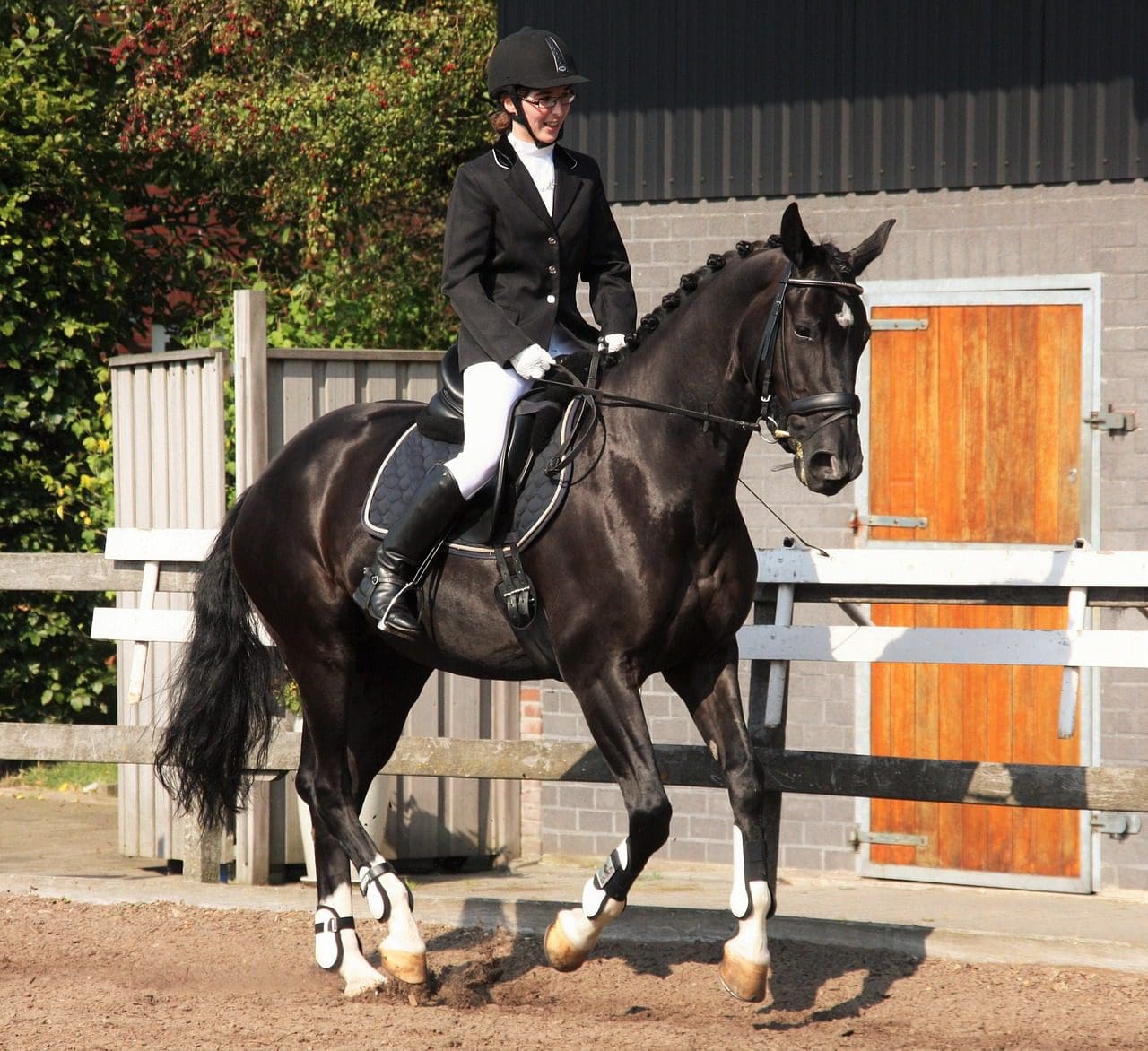
Riding dressage is about creating an effortless partnership, becoming one with your horse, and riding in perfect harmony, with the use of imperceptible aids to communicate movement to your horse. Not every partnership will end up competing at the very highest levels, but your success should be measured by the quality of riding, the enjoyment, and the progress you make together rather than just the level you compete at.
A dressage horse is a horse that has been specially trained to perform specific movements and patterns in a predetermined manner, whilst being scored by a judge in an assessment known as a dressage test. Tests require the horse to carry out complex choreography in a rectangular-shaped arena, whilst giving the appearance of elegance and ease.
The intricate steps must be executed in perfect harmony by the horse and rider with the highest level of precision. A dressage horse must demonstrate grace, powerfulness, and suppleness, possessing high levels of obedience and control. Whilst all horses will benefit from dressage training, not all horses will make great dressage horses.
A good dressage horse must have the correct conformation. A more upright square-shaped build presents a perspective of balance and symmetry. The shoulder, back, and hindquarters will ideally be equal. The back should be compact for greater collection and a shorter neck is preferable.
A good dressage horse should possess strong front leg movement that produces a good length of stride, a powerful hind leg action that allows for top collection abilities, as well as a natural swing in their gaits (walk, trot, canter, gallop). They must radiate great strength, enjoy an even temperament, and be intelligent with a strong work ethic and a willingness to learn.
Not all horses have the necessary conformation to make great dressage horses, but that doesn’t mean you should not train your horse for dressage, as any training will make your horse improve both its fitness and paces. There are specific breeds of horses that consistently produce the desired conformation required by dressage riders, they include Warmbloods, Andalusians, Lusitanos, Baroque Ponies, Morgans, Arabians, and Friesians.
A good dressage rider should have strong basic riding techniques, a good eye for detail, excellent physical balance, be calm under pressure, possess subtle communication skills, and the ability to be able to communicate those precise instructions to the horse. They should be patient, focused, disciplined, have a consistent training regime, and be able to understand the progress in their own form and body awareness as well as their horse’s biomechanics.
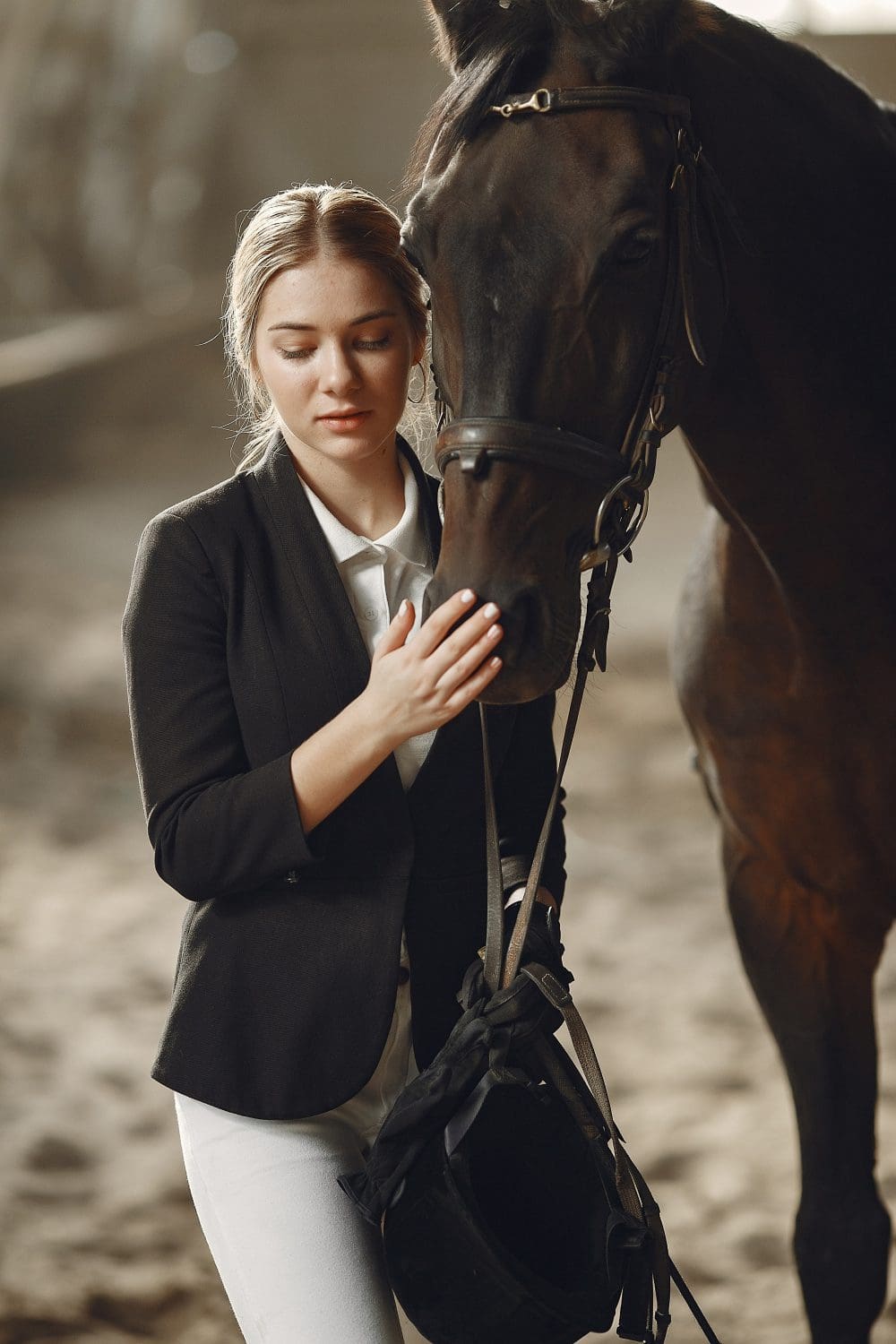
Dressage levels are a standardized way of classifying how advanced the horse and rider partnership is. It also delivers an easy format in which to measure the expected levels of schooling and dictates at what point the horse is ready for the next level.
Each level represents an increase in skills becoming progressively more challenging both physically and intellectually and horses must show consistent proficiency at their current level, before progressing. Dressage is a worldwide sport and there is a hierarchy of equestrian organisations. In lower-level competitions, individual countries are regulated by their national governing body, who is in turn regulated by a National Federation, and ultimately regulated by the FEI who is the International Governing body of equestrian sports and is responsible for upholding the rules, producing the tests, and general oversight of the sport.
In higher-level international dressage competitions, such as the Olympics, Paralympics, and the World Equestrian Games, the FEI (which stands for Fédération Équestre Internationale) also known as the International Federation for Equestrian Sports, oversees dressage competition, imposes the rules and issues tests.
In the UK under the governing body of “British Dressage”, there are seven levels of National tests to compete at. They are:-
In the United States under the governing bodies of the ‘United States Dressage Federation” (USDF), and the ‘United States Equestrian Federation” (USEF) there are six levels of national tests:-
Once a rider has passed these levels, they are able to compete under FEI rules in the following competitions:-
The ultimate goal of any competitive rider is to take part in the Grand Prix. The Grand Prix is what audiences see at major International Competitions. The Grand Prix level consists of three tests culminating in the Freestyle round that is set to music.
In the Freestyle test, the rider produces and performs their own choreographed routine, which must be completed within a specified time limit and include predetermined movements, very similar to the rules in figure skating.
CDI is short for Concours de Dressage International and is the competition standard for International Events, as laid out by the equestrian governing body the FEI. Once you start riding at a more advanced level, then qualification for the CDI is the ultimate goal. It is possible to compete in the CDI as an amateur or professional.
In the UK, British Dressage sets out the criteria required for qualification but has the final say on selection. In addition to competition achievements, you must adhere to FEI membership requirements such as an FEI horse passport, regular horse inspections, and different saddlery and tack requirements. Remember that selection to the CDI means you are actually representing your country in an International competition.
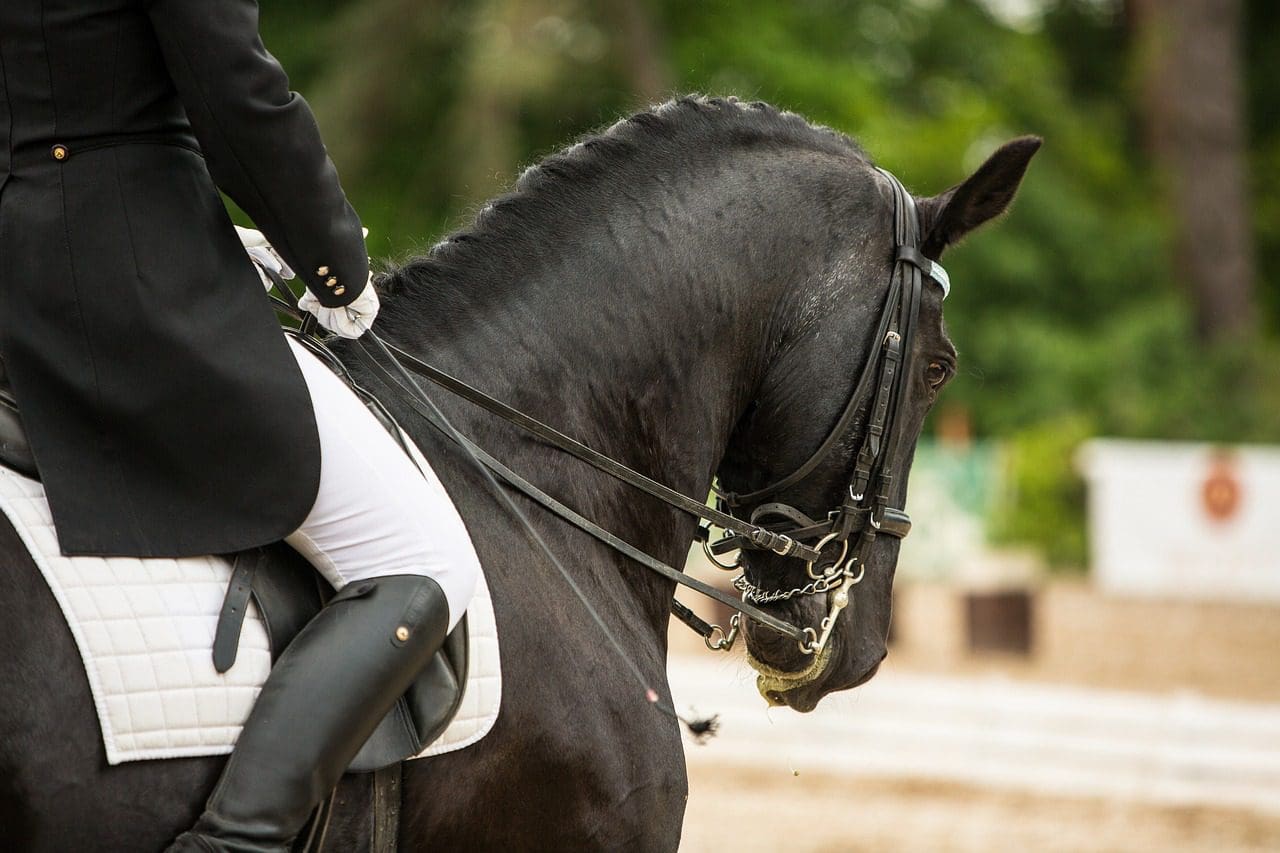
In the USA, the USEF governing body sets out the qualifying criteria. In the event there are more qualifying applicants than invitations, the riders ranking on the Grand Prix 12-month ranking list will be used to determine qualifiers. As part of the selection process, the USEF may designate certain events as selection events.
In addition to competitions, riders can take part in the ancient cultures of “Classical Dressage”, where traditional dressage is performed purely as an art form, rather than a competition. Classical dressage has been preserved by the famous Spanish riding schools in Vienna, Austria, the Escola Portuguesa de Arte Equestre in Lisbon, Portugal, and the Cadre Noir in Saumur, France.
Competitions are evaluated by a panel of accredited judges, who have been registered through their national governing body. (International Judges are accredited with the FEI).
Because scoring has an element of subjectivity, judges are regulated as strictly as possible to ensure fairness and consistency, throughout National and International competitions. Under FEI regulations it is expected that all judge’s final scores be within 5% of each other.
Normally lower level competitions are scored by two, three, or five judges together with their scribe. One judge will sit at the top of the arena (normally sitting at letter C) and depending on the number the other judges will be spread equally around the arena. At the International level, there are between five and seven judges, who spread around the arena to ensure that each movement is judged carefully from all angles.
Marks are awarded for each separate movement on a scale of 0 – 10 with 0 being classed as not executed and 10 classed as excellent. All the individual scores for each movement are added together and calculated as a percentage.
A scribe is a person who sits next to the judge and writes down (known as scribing) the verbal comments made by the judge, together with the scores. This allows the judge to concentrate fully on the horse and rider’s performance without the need to look away to write down comments and miss something. The scribe is also responsible for checking that the identification of the competitor is correct and that the test papers have been completed accurately.
A dressage test is a set of movements that must be executed in a certain manner and to a certain standard as laid down in the rules. The movements must be carried out in the correct order, in a pre-determined route, and in the correct direction using the letters in the arena. In all BD and USDF competitions, apart from Area Festivals, Regionals and Championships, you are allowed to use a “commander” commonly referred to as a caller. The caller is allowed to call out the movements in the order they are described in the test so that you don’t have to memorise the order and can concentrate on the movements themselves.
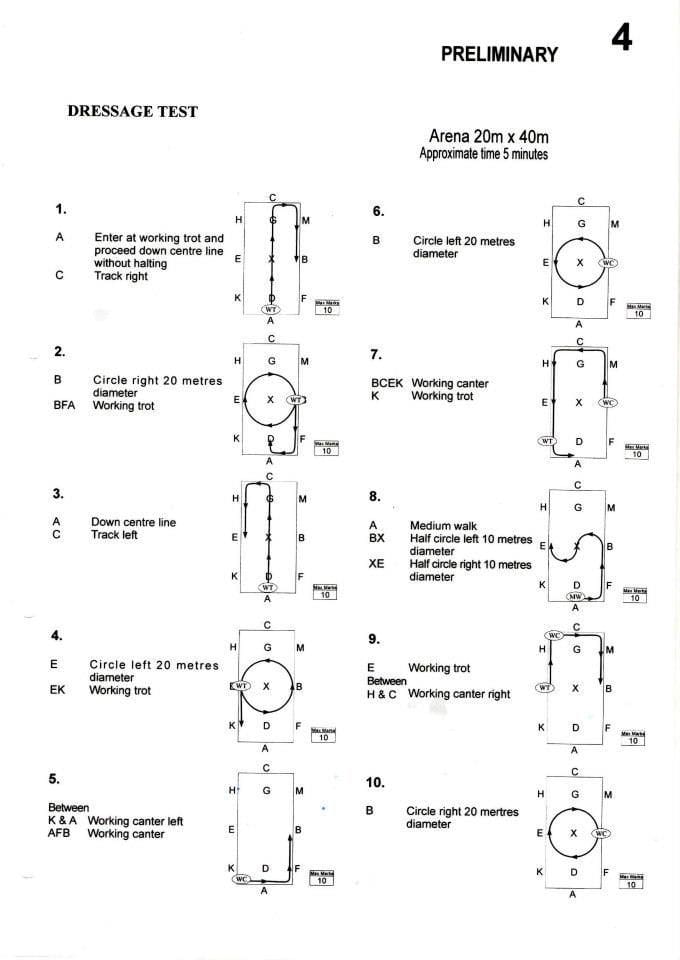
Each event will supply a choice of tests, so you need to choose one and spend time practicing it with your horse. Only once you have mastered the required movements should you enter the competition.
Each dressage level is made up of a number of different tests. Although tests share the same required movements, each test is unique and is numbered. Tests with a lower number are easier to perform than those with a higher number. If you are just starting to compete at a level, it is recommended to learn the lower-numbered tests first, and as you become more accomplished tackle the harder ones.
Just to complicate matters a little further, each level of competition under British Dressage affiliation is split into three categories, Bronze, Silver, and Gold. The level at which you may enter is calculated by your experience and the points won at each level. All three categories compete in the same class and are scored by the same judge, with the results split at the end according to the Bronze, Silver, and Gold categories. The BD rule book describes the sections as follows.
Bronze sections are for less experienced horses and riders who have just started competing at a given level so that they can compete against those with a similar ability.
Silver sections are designed for those combinations that have achieved more ability at a level and have demonstrated that they are no longer a beginner at that level.
Gold sections are for riders who have gained experience at higher levels and are riding a horse with less experience, or for combinations who have demonstrated that they are competent at a level. There is no obligation for a combination to move out of the Gold section at any given level should they not wish to compete at the levels above.
Generally scores greater than 70% are considered to be very good and 60 – 70% are good. Both the UK and USA state that when you are consistently scoring in the high 60s on the harder tests, it is probably time for you to move up to the next level. The FEI’s advice is that you should always be schooling/training your horse a level above the one you are competing in.
Under BD (British Dressage) rules, certain competitions are classed as qualifiers (marked with a Q on the show schedule) These allow you to gain points which can be used to gain qualification to Area Festivals, Winter and National and Area Championships, Quest semi-finals and Championships. Points are awarded on a sliding scale for any result over 60%. For example, a result of 60-61.99% is rewarded with one point, up to 11 points for a result of 80% and above.
When scoring a test the judge will assess each movement separately. Judging begins when a rider enters the Arena (normally at the letter A) and finishes when the rider moves off from the final salute. Riders will be awarded marks for each numbered movement and collective. If there is more than one judge, the scores are averaged to obtain the final result.
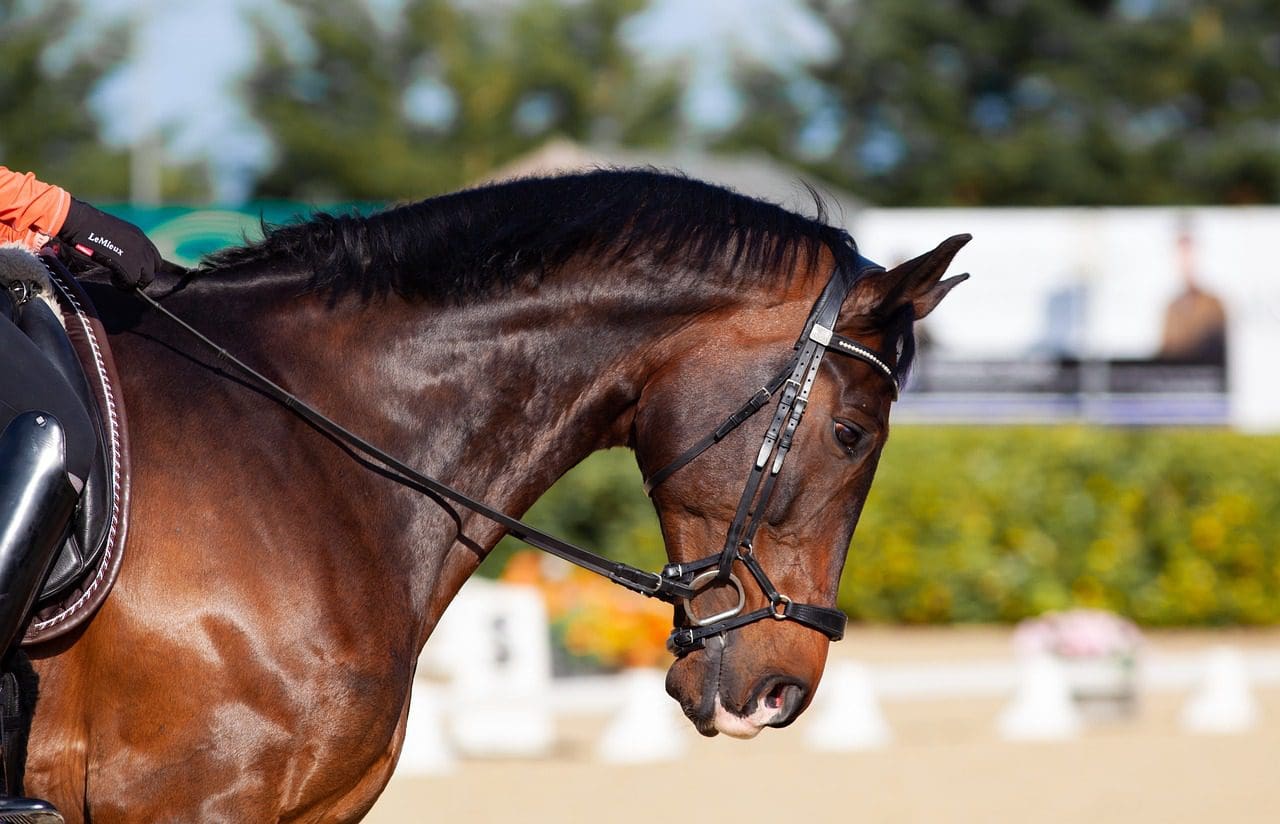
In addition to scores for movement, judges will also award marks for actions known as “Collectives”. Collectives are also marked from 0 – 10 and added to your final score.
In the UK marks are awarded for the following collectives.
In the US the collective Mark Categories are as follows
If a rider makes an error, the judge will ring a bell to pause the test and explain at what point the rider may recommence the test. Every error will receive a deduction. Two points for the first error, four points for the second, and after the third error the rider is eliminated.
Judges evaluate dressage tests based on the rider’s accuracy, grace, and connection to the horse. In addition, judges consider the execution of movements, how well the test was presented, and the rider’s position in the saddle. They look for a harmonious performance between rider and horse that emphasizes the correct placement of all legs and consistent tempo throughout. To score highly, riders must demonstrate their horsemanship with precision and clarity.
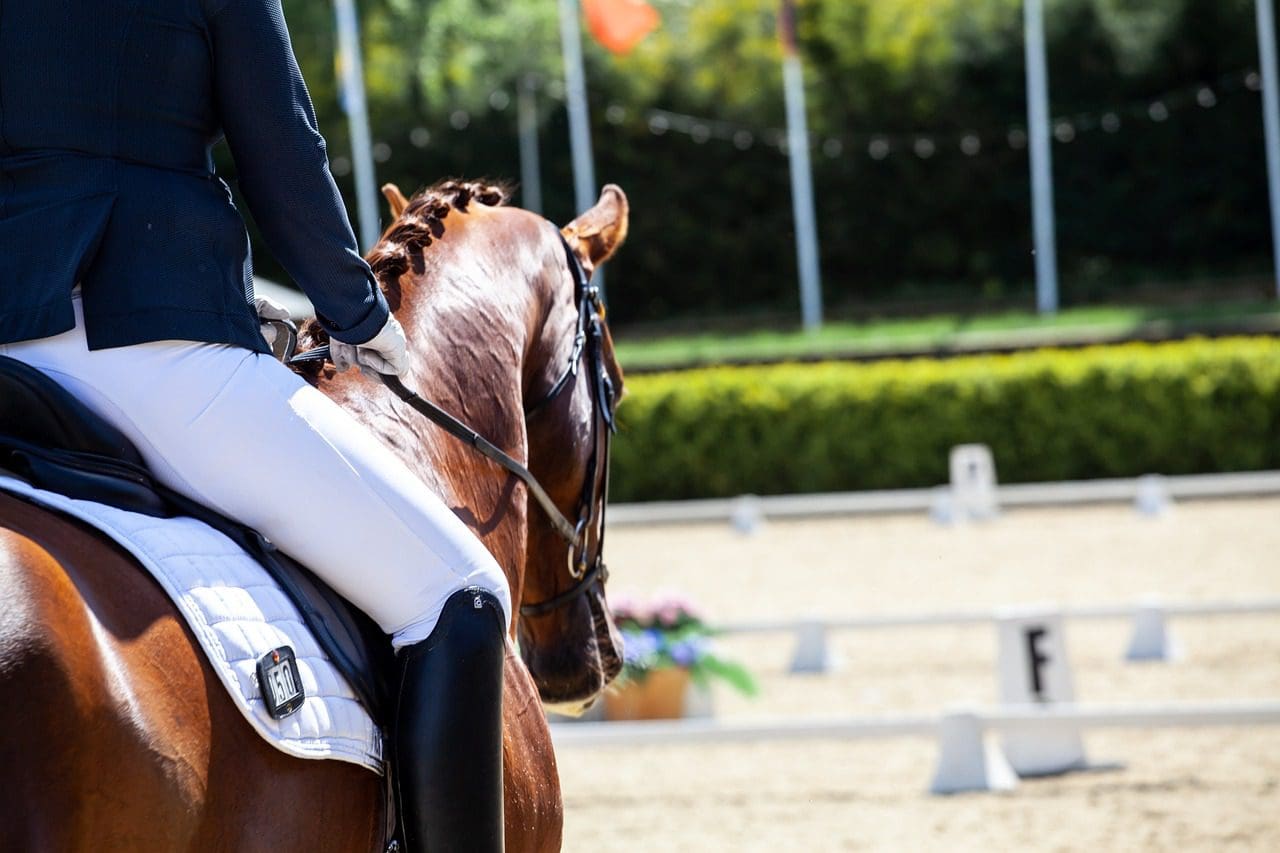
Taking part in your very first competition can be daunting and the judges intimidating, but just remember everyone had to start where you are now, so at some point in their lives will have been in the same position. It is definitely worth watching a few competitions to familiarise yourself with the format, so you know what to expect before taking part yourself. Here are a few pointers to help you.
Unaffiliated dressage refers to competitions that are run by unaffiliated clubs or organsiations. When we say unaffiliated club, we mean one that is not under the umbrella of or regulated by an official organisation. In the UK the official governing body is British Dressage.
Unaffiliated competitions allow riders to gain experience in a more stress-free environment, without the pressure of earning points or qualification to higher levels or championships. Judges are not required to be BD accredited, so the scoring may not be as consistent.
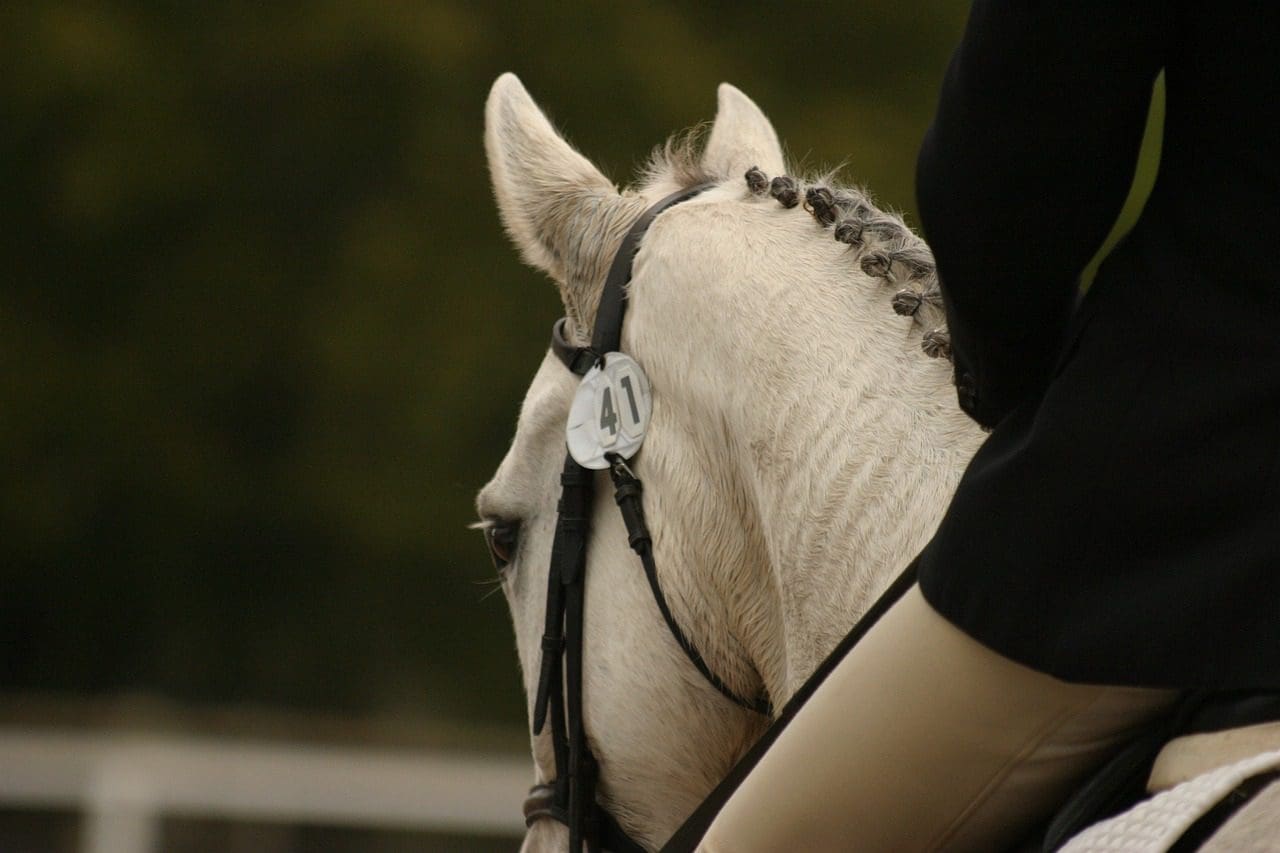
Most unaffiliated competitions follow affiliated rules, although, in local shows, the dress code tends to be a bit more tolerant, you should always ensure you are as smartly turned out as possible. As a BD member, you are still able to compete in affiliated and unaffiliated competitions.
If you want to take part in affiliated competitions, you must be a paid member of British Dressage. There are various levels of membership available and they are:-
Full (competing) – Access to all events and shows.
Trial – All the benefits of full membership on a three month trial.
Winter – Full member benefits for the six-month winter period (1st october – 31st March).
Full (non competing) – Aimed at owners, trainers and officials, allows you to own a competing horse and officiate at events but have no eligibility to compete.
Club – Access to all quest classes, Music Classes, Prelim, Bronze, and Combined Training
BD Community – Free access to schedules and results
Eventing is a three-day event that combines three disciplines, cross country, showjumping, and dressage. The Eventing dressage phase is exactly the same as standard dressage, with the same basic requirements, rules, and tests. Eventing judges are just as well trained to evaluate tests to the same standards. However, there can be a big difference between the requirements, especially when comparing International level dressage and International Eventing dressage. The main reason for this is that an Eventing horse has to be able to compete successfully at all three events and therefore successful event horses tend to be very good at all three disciplines rather than excelling at just one.
Dressage movements are specific manoeuvres communicated to the horse by the rider, where the horse using its, body and legs transfers its position to different parts of the arena in a certain manner.
Under UK dressage rules, the Introductory level is the easiest. Your horse will only be asked to walk and trot (10 metre circles in walk, three loop serpentines, and 20 metre circles in trot). You may already be able to do this, but you will be expected to be able to change direction and smoothly transition through the paces at a steady speed with good balance. For each movement or gait, you must ensure that the rhythm and tempo are correct.
As you progress through the levels, you will be expected to carry out the movements from all previous levels as well as the new movements introduced at that level.
Canter is introduced at the Preliminary level (Half 10 Metre circles in walk and 20 metre circles in trot and canter).
Counter Canter and lengthened strides are introduced in Novice (Half 15 metre circles in canter, Counter Canter, and Medium Trot).
Elementary introduces lateral work (Collected trot/canter, simple change, and leg yields).
The medium level sees a jump in difficulty (Extended trot/walk, Walk pirouette, and half pass in trot and canter).
Flying changes are introduced at Advanced Medium.
In the levels above advanced, including PSG, Intermediare, and Grand Prix, you will be expected to be able to perform Canter Pirouettes, Sequence Flying Changes, Piaffe, Passage, and Canter Zig Zags.
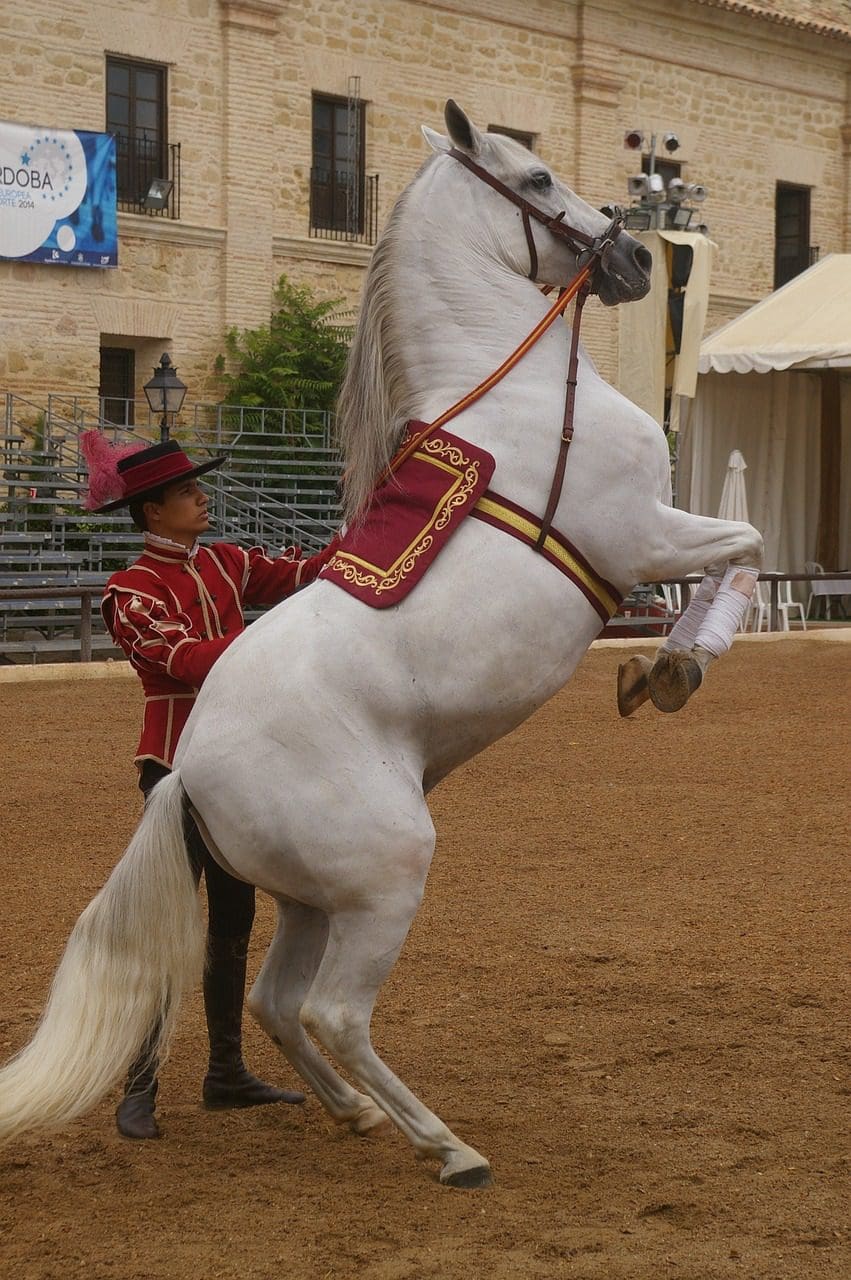
Under the United States Dressage Federation Rules, the levels and requirements are slightly different and each level is split into three tests, which get progressively harder. Each test is accompanied by a “directive” which states the purpose of the test and the overall concept for the level.
The first level is the introductory level and as the name suggests is a simple introduction to the sport
Movements introduced at Introductory Level
The directive states “To introduce the rider and/or horse to the sport of dressage, confirming that they are beginning to develop an understanding of correct dressage basics. The horse should be ridden freely forward in a steady tempo and clear rhythm, accepting contact with the bit. An understanding of test accuracy and geometry should be demonstrated”
The next level up is the Training Level.
Movements introduced at Training Level
The directive states “To confirm that the horse demonstrates correct basics, by showing suppleness both laterally and longitudinally, moving freely forward in a clear rhythm with a steady tempo, and readily accepting contact with the bit. Correct geometry and lines of travel should be shown. All trot work may be ridden sitting or rising unless otherwise stated. Halts may be through the walk”
The next level is the first Level.
Movements introduced at First Level
The directive states “To confirm that the horse performs correct basics, and in addition to the requirements of Training Level, has developed the thrust to achieve improved balance and throughness and maintains more consistent contact with the bit. All trot work may be ridden sitting or rising unless otherwise stated.”
The next level is the second level.
Movements introduced at Second Level
The second level directive states “To confirm that the horse demonstrates correct basics and now begins to accept more weight on the hindquarters as the collected and medium gaits develop. A greater degree of straightness, suppleness, throughness, and balance is required to perform the movements with ease and self-carriage. All trot work must be done sitting”.
Movements introduced at Third Level.
The third level directive states “To confirm that the horse demonstrates correct basics while maintaining consistent uphill balance and self-carriage. Increased engagement facilitates clear differences in collected, medium, and extended gaits with well-defined, balanced transitions. Movements should be accomplished with harmony and ease due to the increased balance and collection. The horse must demonstrate a greater degree of throughness, suppleness, straightness, and bending. All trot work must be done sitting”.
The final level before moving to FEI competition is the fourth level.
Movements introduced at Fourth Level
The fourth level directive states “To confirm that the horse demonstrates correct basics, and has developed sufficient suppleness, balance, and impulsion to perform with ease the exercises at this medium level of difficulty. The horse has established consistent self-carriage and lightness through improved connection, engagement, and collection. The movements and transitions are performed with greater straightness, impulsion, and cadence. All trot work must be done sitting”.
Any advanced movement is difficult, but probably the hardest movement to master is the canter pirouette. The horse’s hind legs remain in the same place, whilst the horse canters on the front legs in a circle (pirouette), which requires huge elevation and a high degree of strength and collection.
Western dressage is an equestrian discipline of horse riding that has been established in the United States. It draws elements from both classical dressage and western riding.
There are several differences between the two sports, not only in the type of horse tack and vestments ( English dressage necessitates the use of an English saddle. traditional dressage attire, breeches a long tail coat or jacket, and a helmet, whilst Western dressage uses a Western type Saddle and clothing of pants or jeans, button up shirt, cowboy boots, and a Western hat), but the Western sport also has its own movements specifically designed to show off the best qualities of western horses.
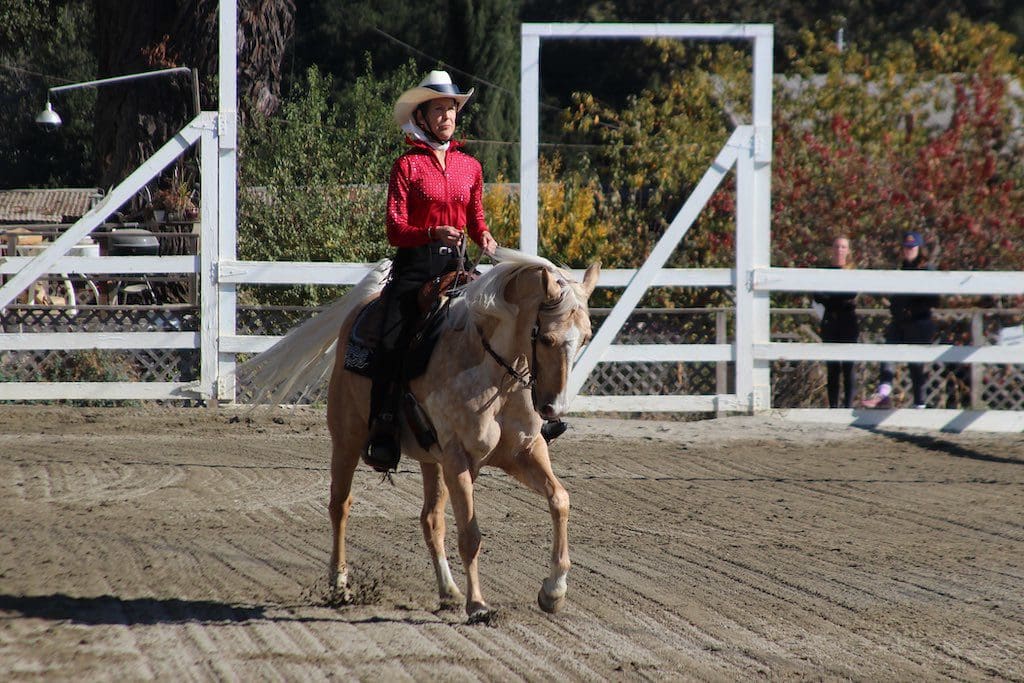
The sport is controlled by the WDAA (The Western Dressage Association of America) and is affiliated with the United States Equestrian Federation (USEF). It is certainly popular and there are WDAA groups in nearly every state.
The WDAA authorises competitions, tests, and even virtual tournaments, where competitors upload videos of themselves riding in order to be judged. Similar to English dressage, tests are carried out in a lettered arena and use an identical scoring system with accredited judges, however, the specific requirements at each level differ.
There are many more tests available at each level which allows for smaller increases in difficulty. Other differences see Western tests contain motions not found in English tests such as “Turn on the forehand” a movement western horses require when working trail obstacles. Also, “Turn on the haunches” and “Backing up” are introduced much earlier in Western Dressage for the same reasons.
There is no question it is extremely popular in the United States and has associations in other countries such as the Western Style Dressage Association of Canada and the Western Dressage Association of Australia.
A dressage arena is a rectangular area, enclosed by a fence or boards, in which riders compete, performing required movements of their dressage tests, within the arena boundaries. The arena can be indoors or outdoors and the surface grass, sand, wood chippings, rubber, or a combination of sand and rubber.
In competitions there are two sizes of arena, the first is 20 x 40 metres in size and is used in lower-level competitions. The second is 20 x 60 metres in size and is normally reserved for higher-level and international competitions.
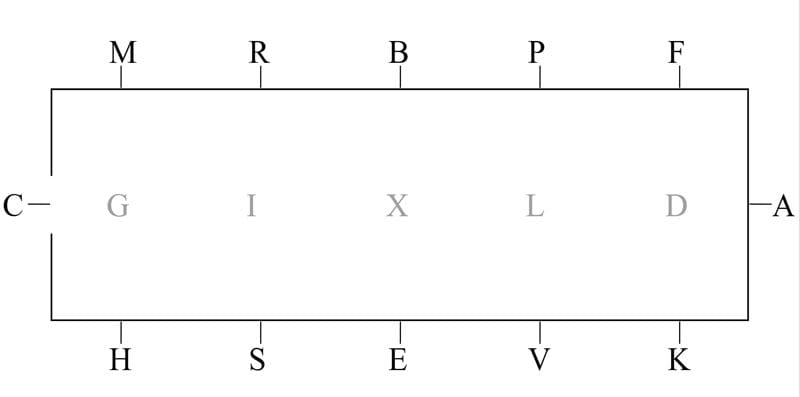
Each size arena is divided up by letters. The longer the arena size the more letters are required, although both have a C marked at the far end and an A at the other end where the horse and rider usually enter the arena, with an X marking the dead centre. The small arena is marked with the letters K, E, and H on one side and F, B, and M on the other with the letters D and G down the centre line. The larger arena has K, V, E, S, and H on one side, F, P, B, R, and M on the other side, and D, L, I, and G down the centre line. All letters are spaced equally.
First of all, it is important not to rush your horse’s training. Training a horse for any discipline requires consistency, patience, and an appreciation of the animal.
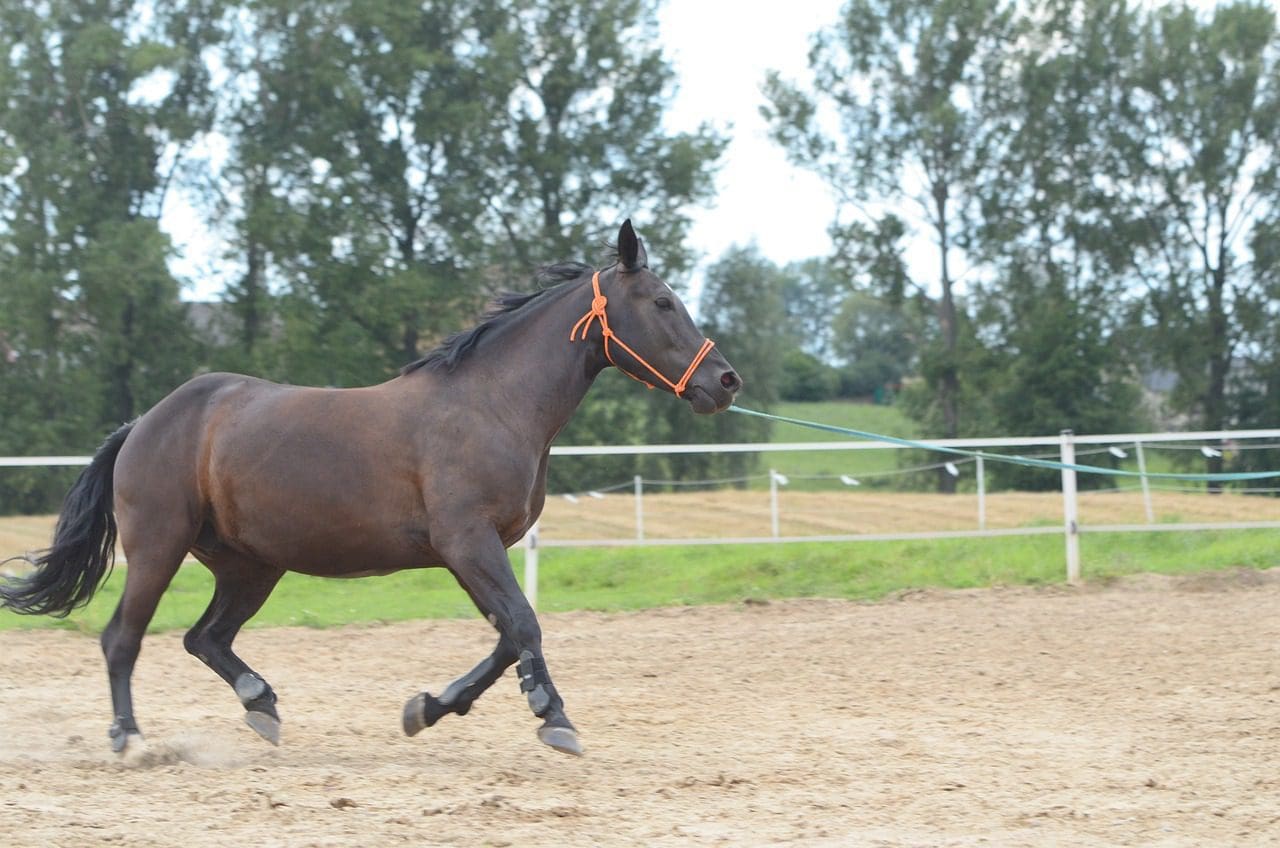
Much like humans learning at school, every person is different and each learns at a different pace. Horses are just the same. Each horse will learn and build their strength and muscle at a different rate. You will need to understand the pace at which your horse develops, so that you don’t push them too hard, or too quickly, but find the training sweet spot.
To achieve training in dressage with a horse, basic groundwork is essential to create understanding and trust between rider and horse. Groundwork isn’t just about lunging or long reining, it is about spending time at ground level eye to eye with your horse.
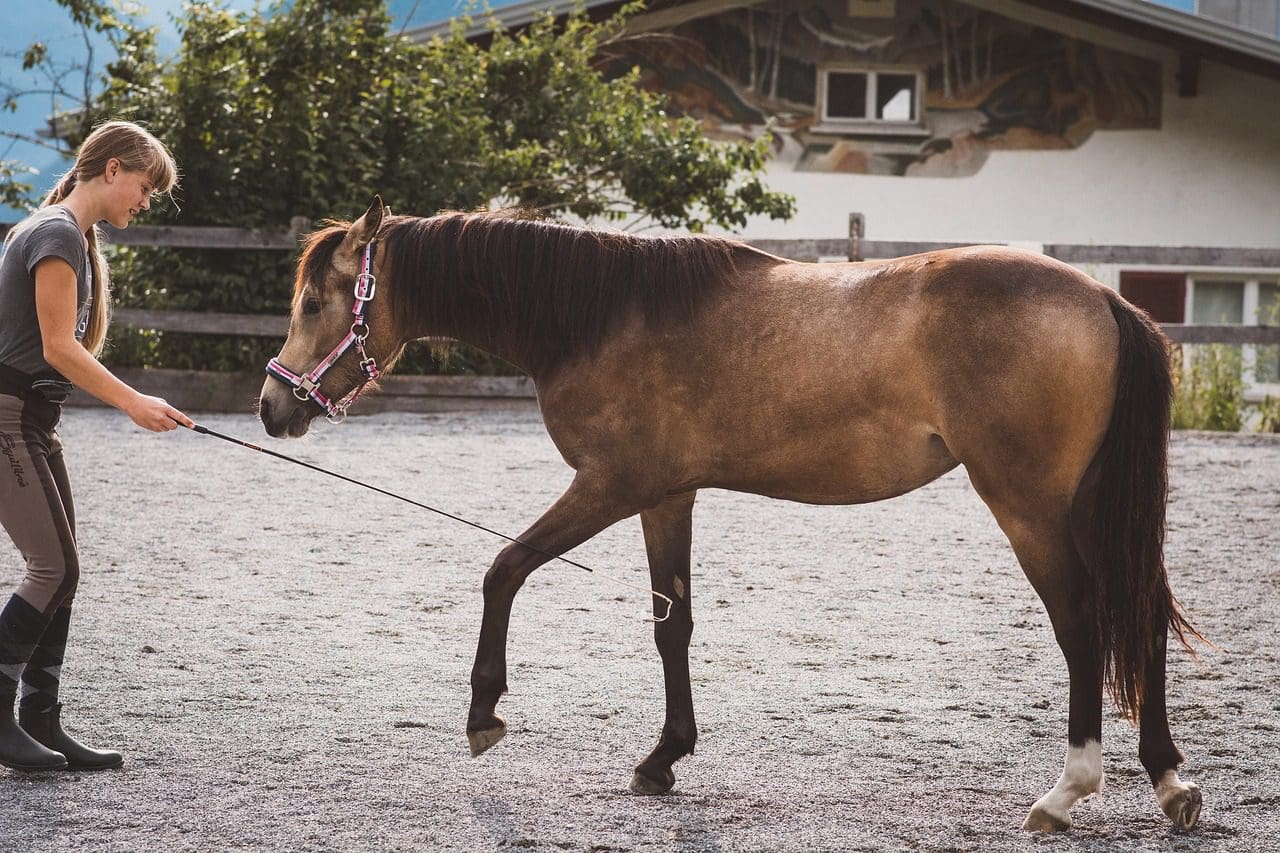
Leading, cleaning, brushing, building trust with your horse, backing up, stepping forward, standing still, moving sideways, lifting a foot, lowering the head. These are just a few examples of the many lessons you can teach your horse from the ground so that they will remember and build a solid foundation by the time you start to ride.
It is crucial to introduce a qualified trainer as soon as possible, someone who understands your goals and can assist you with the initial groundwork. They will help to gradually introduce low-level dressage exercises with regular repetition and positive reinforcement. Once your horse has mastered each exercise and built up sufficient muscle, you will be able to introduce more complicated training. Understand the Pyramid of training (scales of training) and apply the six core elements to your training plan.
Remember that this is a training regime for you as well as the horse, and you will need to practice the correct riding techniques as well as work on your own well-being, posture, strength, suppleness, stamina, and stability. When training for competition, make sure you learn and remember the order of movements required in tests, as this is one less thing to worry about when practicing with your horse.
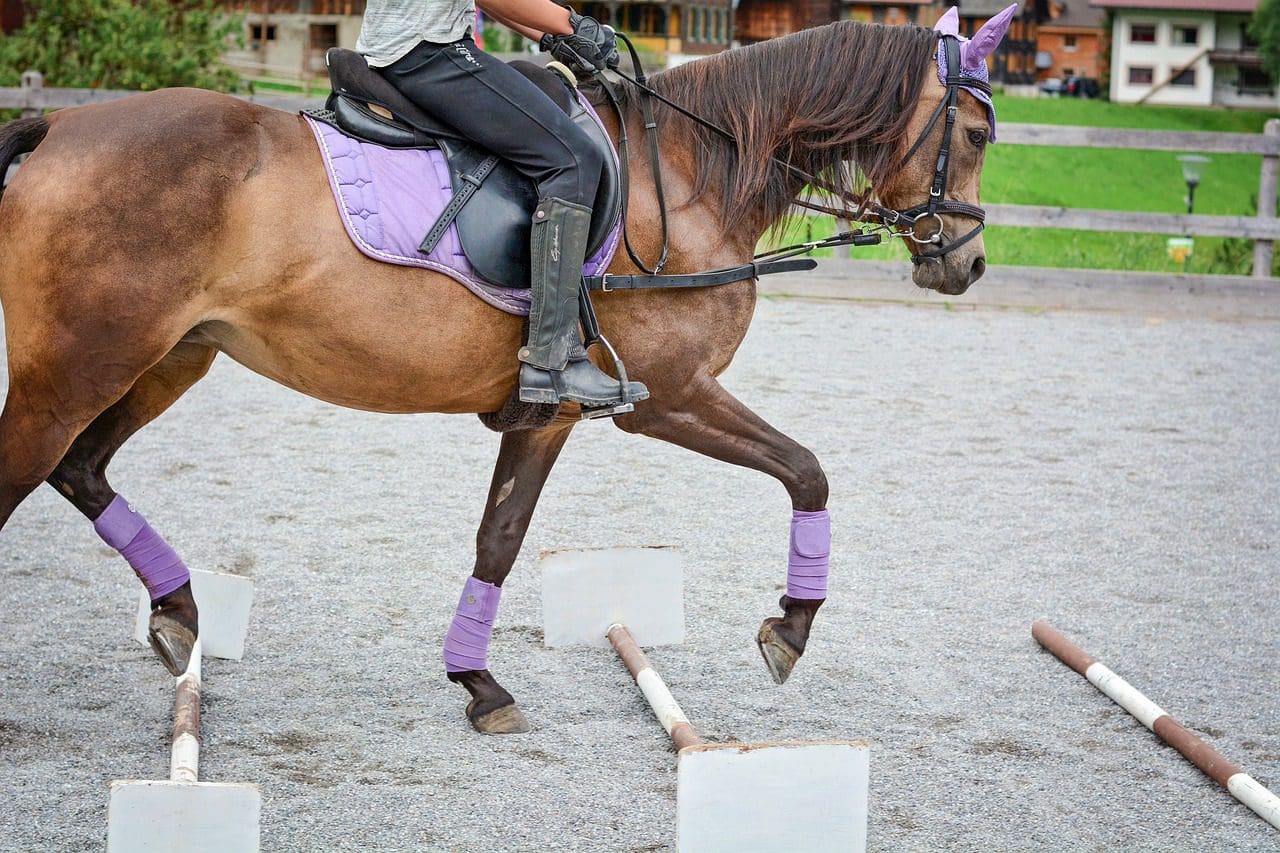
Repeating the same training can be just as boring for you as for your horse. Don’t be afraid to mix things up, take your horse for a hack, outside the arena, or throw in a bit of jumping. A happy horse and rider will be much more willing to learn.
From a stranger’s perspective, the best horses and riders in the world appear to make dressage look easy and many people assume that the horse performs movements naturally and the rider is just sitting there. The reality couldn’t be further from this perception. Whilst it is true that a horse is naturally capable of all the dressage movements, it is the expertise of the rider to get the horse to perform the movements on command and at the right time that is the real skill.
Given that most horses are normally ridden from the age of three and the age of horses who compete at the International Level is between 12 and 15 years. It takes approximately ten years to train advanced horses to the top levels of dressage.
To ensure a level playing field there are strict rules on the tack you can and cannot use on your horse. The British Dressage rules and regulations are updated at least twice a year to take into account new technology and styles and the BD and USDF have pages of guidance on which saddles, bridles, bits, whips, and bandages, are allowed, but briefly, this can be condensed down to the following.
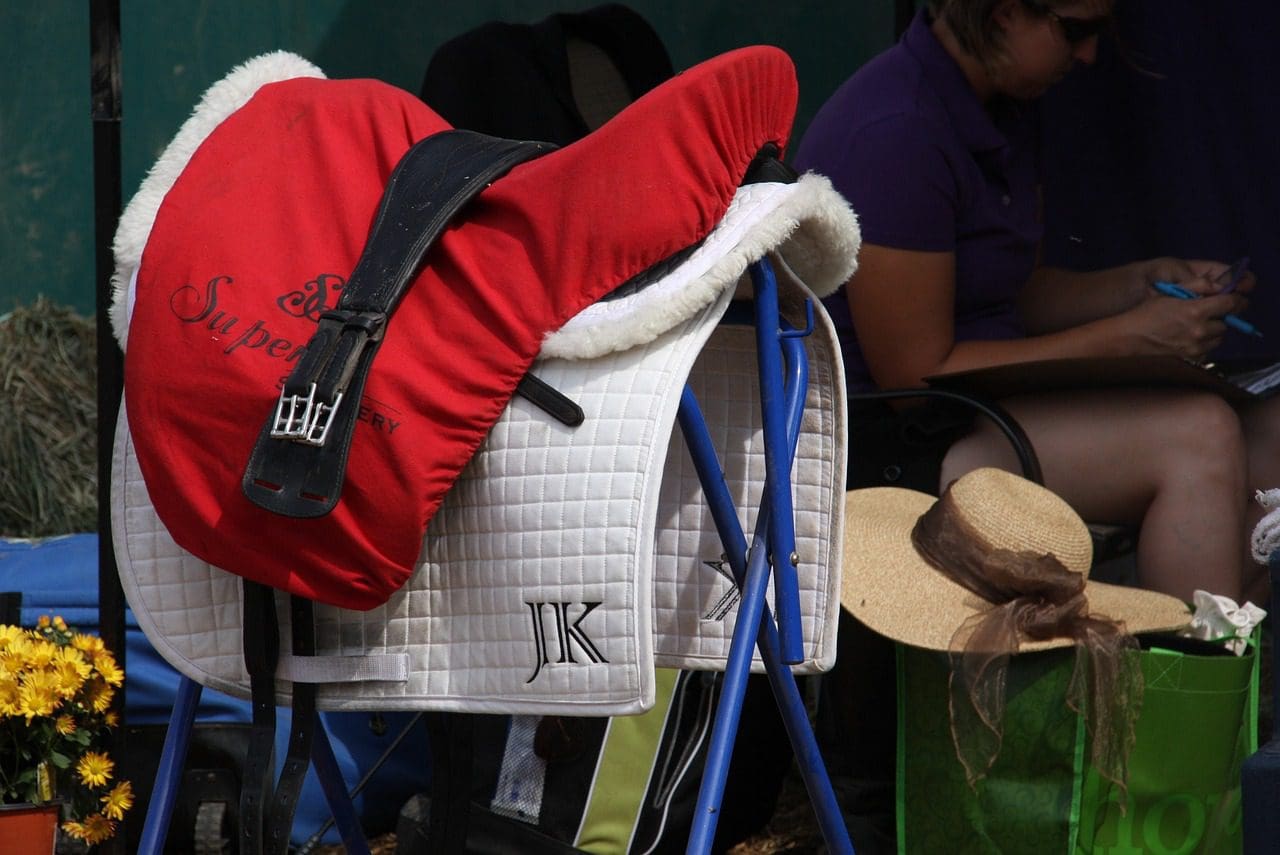
English or continental style saddle with flaps, a cantle, and pommel which are brown, black, grey, or navy in colour. (Panels of colour are allowed). Most serious competitors will ride in a saddle that has been designed specifically for dressage (known as a dressage saddle) with longer straighter flaps, a pronounced knee block, and longer billets that require a shorter girth (known as a dressage girth).
Saddle cloths or numnahs should be white/cream and are allowed to have contrasting piping. Saddle cloths may show the name or logo of a riders sponsor, subject to size restrictions.
Bridles must be used in the conventionally accepted manner and include a browband, a noseband, and a bit. Acceptable colours are Black, Brown, Grey, or Navy. Padding is allowed on the noseband and poll. Drop nosebands, Grackles and Flash Nosebands are all acceptable. At the International level a double bridle is compulsory Bridles without a throat lash are acceptable in National Competitions.
There is a large range of accepted bits, but you will find that affiliated lower-level competitions only permit a snaffle bit. You are NOT ALLOWED to use a bit with a central plate, a cable single or double jointed bit, B ring snaffles, straight bars with textured mouthpieces, kimblewicks, rotating baucher, bit guards, bit clips on ergonomic bridles, or full cheek snaffles.
Ear covers are permitted for all competitions and include noise-reduction elements. Ear covers should be a discrete colour. No horse boots, bell boots, or bandages (including tail bandages) are allowed during the competition. You are not allowed to use a martingale or any training aids.
Red bows should be worn in the tail to denote horses that kick and anyone riding a stallion in competition, should identify themselves with a yellow cross band or stallion disc on the bridle.
It is expected that your horse will be immaculately groomed and turned out to a high standard and whilst not compulsory it is commonplace for horses to have their manes braided or plaited. It is generally considered correct for manes to be plaited or braided on the right. The size of braids vary, in the USA braids tend to be smaller and in Europe and the UK braids tend to be larger.
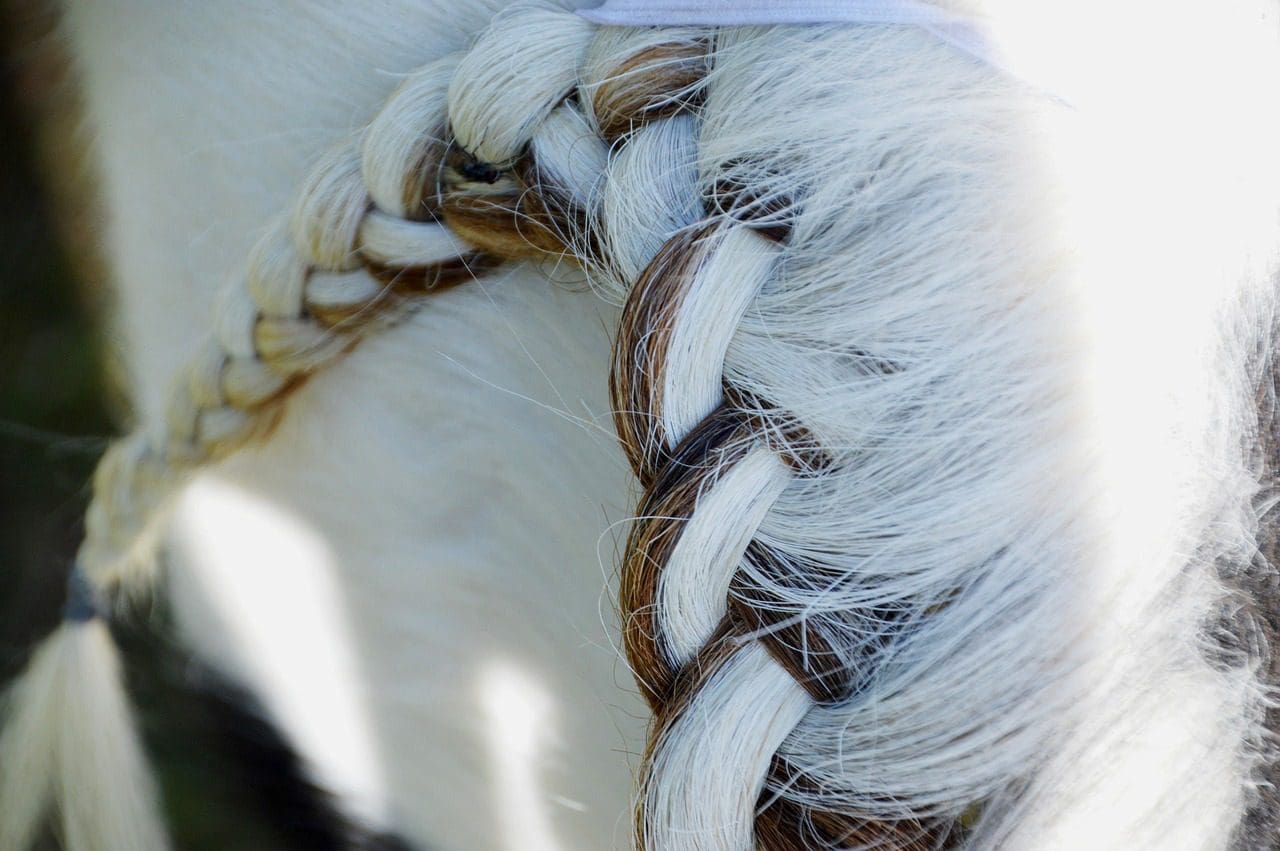
Rather like a school uniform, rules on dressage attire are there to ensure that every competitor looks smart and as similar as possible so that competitors are judged purely on their equestrian abilities rather than how they look.
Jackets may be in any conservative colour and must be worn in all championship, regional, and high-profile classes. Navy jackets with red collars are not allowed unless you are a team rider. Fitted waistcoats are permitted in a conservative colour and may be worn over a long or short sleeve shirt that fastens at the neck with a tie, round collar or correctly fastened stock in a solid pale colour.
A riding hat designed to provide protection but be worn at all times by anyone mounted. Protected hats must meet certain quality standards laid out in the rule book. Mirrored hats and top hats are not allowed.
Breeches or jodhpurs must be plain white, cream, beige or canary yellow, except when worn with official services uniform.
Gloves must be worn and spurs may be worn at all levels. The band round the heel must be smooth and any shank must point towards the rear and pointing downwards. Comb spurs are not allowed.
Conservatively coloured body protectors and air jackets are permitted.
The first step is to find yourself a horse. We all dream of being able to afford a horse that oozes ability and can move like Valegro. However, it is important to remember not to get ahead of yourself and be realistic. Schoolmasters can be great, but these horses are also very finely tuned, so the slightest movement to your seat or leg can change the horses’ way of going, and before you know it they are piaffing down the centre line!
If you are a less-experienced rider, then buying a sharp 4-year-old that trots with its knees up around its ears may also not be a sensible idea. Careful consideration should be given to your budget, your riding ability, and your realistic goals and aims. It is also worth taking a knowledgeable rider/trainer/friend to any potential viewings. A good point to remember is that most horses no matter the breed or type can progress up the levels with the correct training, some will just find it easier than others.
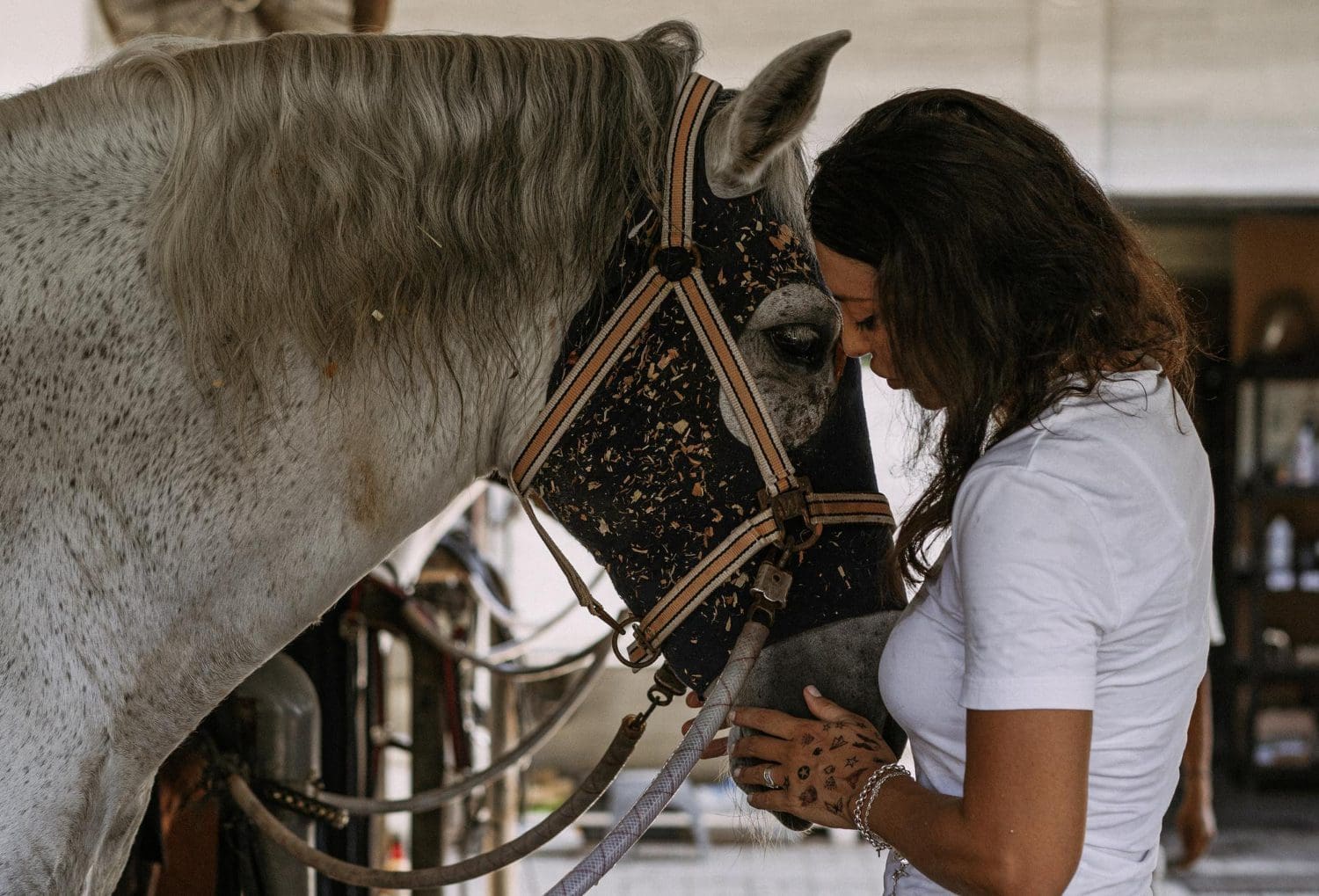
It is important not to become over fazed and allow yourself to learn with your horse as you go. Whilst you should have some basic riding ability, don’t be put off from competing. The intro tests are nice and basic requiring only walking and trotting as standard movements. As long as your aiming to compete at a level suitable for your horse, you should be fine.
If you want to take training seriously, a good trainer from day one is worth their weight in gold. Someone that understands you, and your horse and believes in your dreams and goals. Ideally, if you are purchasing a horse you should be confident with the basic walk, trot, and canter. However, a good trainer will help you develop the paces.
Intro and Prelim require the paces to be of ‘working’ standard, therefore the horse’s forward pace will be adequate. However, as you progress up the levels there will be more demand on the paces, with collection and extension. As well as the introduction of lateral work.
Flatwork is the key to all disciplines. It is so important that horses are able to work in a correct elastic frame over their backs, with good suppleness. This assists with strengthening the topline and core which will aid the horse no matter what discipline they perform in. Adjustability within all 3 paces and basic lateral work such as shoulder in and leg yield would be of benefit.
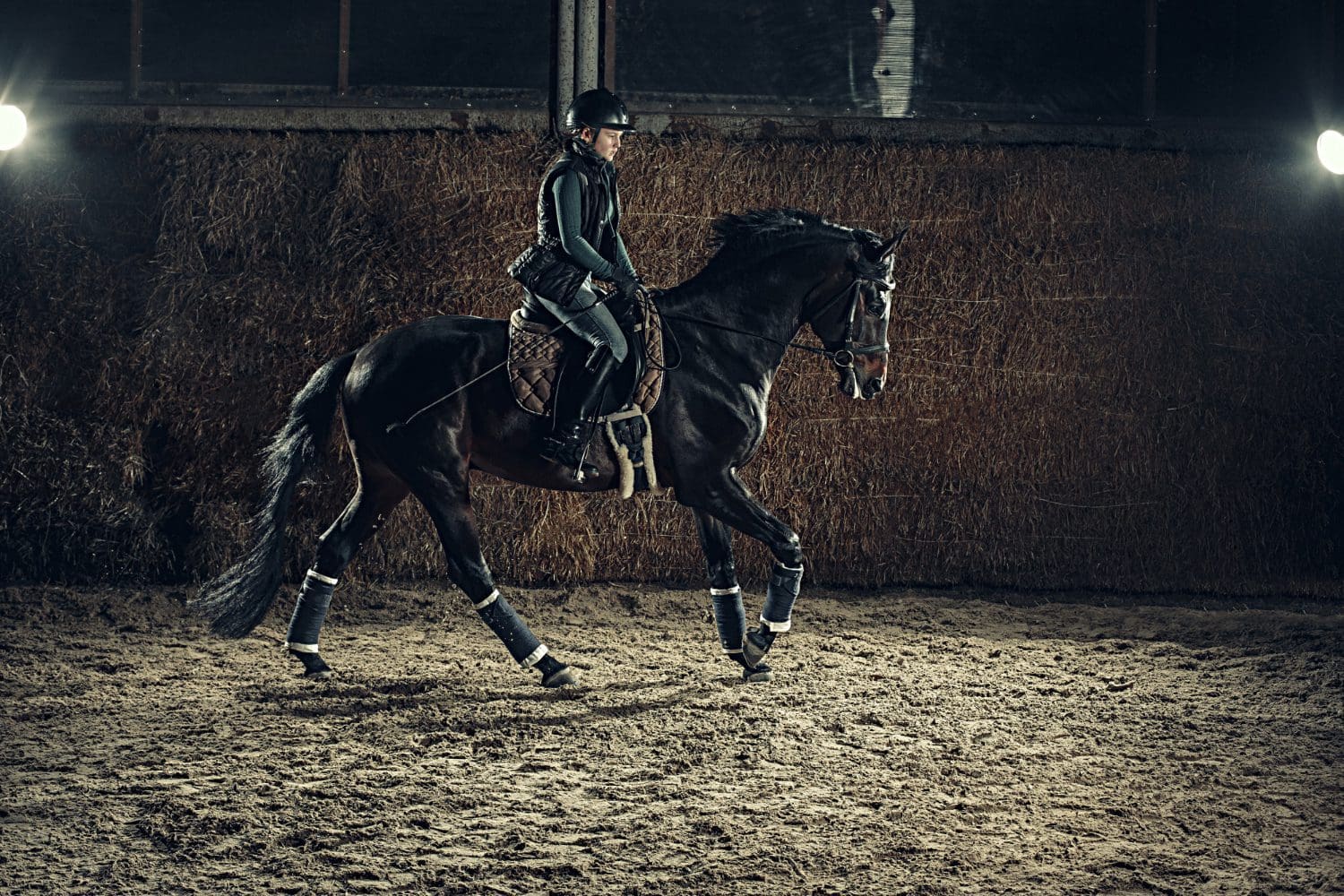
I hope you have found this article informative and that it has given you the inspiration to begin your dressage journey, or assist you along the way. Dressage is for anyone interested in horse riding and done properly you and your horse can only benefit from the training. We have written or are in the process of writing more in-depth articles on specific topics which we will link to. In the meantime, if you have any specific questions please feel free to contact us.
Established in 2007, our expertise lies in producing custom horse bridles with interchangeable parts, meticulously designed to ensure optimal fit and made from premium European Leather for both functionality and aesthetics. Our commitment to excellence extends beyond mere craftsmanship and we take pride in assisting equestrians worldwide in finding products tailored to their horses’ unique needs.
Distinguished by our innovative online software configurator, we offer a unique experience where you can personally design various pieces of horse equipment, ranging from Horse Bridles and Girths to custom saddle pads, Browbands, Bandages, and Ear Bonnets. Regardless of your equestrian discipline, we cater to your requirements with precision and care.
Moreover, for those with a penchant for dressage, we boast an array of exceptional products such as dressage saddle pads, dressage bridles, ear bonnets and whips, designed specifically to elevate your performance. Explore our website for further details and discover how our products can enhance your dressage journey.
We have also been working hard on our Pink Equine Blog, to bring you informative and interesting articles such as this one. If you would like to receive notification of more articles as and when they are published, whilst enjoying access to competitions, member discounts and a free newsletter, then we invite you to join us by registering FREE as a member.